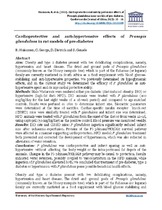| dc.contributor.author | Huisamen, B. | |
| dc.contributor.author | George, C. | |
| dc.contributor.author | Dietrich, Danielle | |
| dc.contributor.author | Genade, S. | |
| dc.date.accessioned | 2018-01-10T13:38:28Z | |
| dc.date.available | 2018-01-10T13:38:28Z | |
| dc.date.issued | 2013 | |
| dc.identifier.citation | Huisamen, B. et al. (2013). Cardioprotective and anti-hypertensice effects of Prosopis glandulosa in rat models of pre-diabetes. Cardiovascular Journal of Africa, 24(2): 10 - 16. | en_US |
| dc.identifier.issn | 1995-1892 | |
| dc.identifier.uri | http://dx.doi.org/10.5830/CVJA-2012-069 | |
| dc.identifier.uri | http://hdl.handle.net/10566/3373 | |
| dc.description.abstract | AIM: Obesity and type 2 diabetes present with two debilitating complications, namely, hypertension and heart disease. The dried and ground pods of Prosopis glandulosa (commonly known as the Honey mesquite tree) which is part of the Fabaceae (or legume) family are currently marketed in South Africa as a food supplement with blood glucose-stabilising and anti-hypertensive properties. We previously determined its hypoglycaemic effects, and in the current study we determined the efficacy of P glandulosa as anti-hypertensive agent and its myocardial protective ability.
METHODS: Male Wistar rats were rendered either pre-diabetic (diet-induced obesity: DIO) or hypertensive (high-fat diet: HFD). DIO animals were treated with P glandulosa (100 mg/kg/day for the last eight weeks of a 16-week period) and compared to age-matched controls. Hearts were perfused ex vivo to determine infarct size. Biometric parameters were determined at the time of sacrifice. Cardiac-specific insulin receptor knock-out (CIRKO) mice were similarly treated with P glandulosa and infarct size was determined. HFD animals were treated with P glandulosa from the onset of the diet or from weeks 12–16, using captopril (50 mg/kg/day) as the positive control. Blood pressure was monitored weekly. RESULTS: DIO rats and CIRKO mice: P glandulosa ingestion significantly reduced infarct size after ischaemia–reperfusion. Proteins of the PI-3-kinase/PKB/Akt survival pathway were affected in a manner supporting cardioprotection. HFD model: P glandulosa treatment both prevented and corrected the development of hypertension, which was also reflected in alleviation of water retention.
CONCLUSION: P glandulosa was cardioprotective and infarct sparing as well as anti-hypertensive without affecting the body weight or the intra-peritoneal fat depots of the animals. Changes in the PI-3-kinase/PKB/Akt pathway may be causal to protection. Results indicated water retention, possibly coupled to vasoconstriction in the HFD animals, while ingestion of P glandulosa alleviated both. We concluded that treatment of pre-diabetes, type 2 diabetes or hypertension with P glandulosa poses possible beneficial health effects. | en_US |
| dc.language.iso | en | en_US |
| dc.publisher | Clinics Cardive Publishing | en_US |
| dc.rights | This is the author-version of the article published online at: http://dx.doi.org/10.5830/CVJA-2012-069 | |
| dc.subject | Prosopis glandulosa | en_US |
| dc.subject | Hypertension | en_US |
| dc.subject | Cardioprotection | en_US |
| dc.subject | PKB | en_US |
| dc.subject | Insulin resistance | en_US |
| dc.title | Cardioprotective and anti-hypertensive effects of Prosopis glandulosa in rat models of pre-diabetes | en_US |
| dc.type | Article | en_US |
| dc.privacy.showsubmitter | FALSE | |
| dc.status.ispeerreviewed | TRUE | |
| dc.description.accreditation | Department of HE and Training approved list | |

